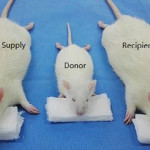
WHY THIS MATTERS IN BRIEF
- Scientists have been performing head transplants on animals for decades, and now a Chinese team want to move to human trials by the end of the year
Following hot on the heels of the creation of a Human-Animal hybrid “animal,” a team of Chinese scientists have just announced that they’ve successfully transplanted the head of one rat onto another rat, in essence creating a Franken-Rat, and they hope that the procedure will help them perform the world’s first human head transplant by the end of the year.
The operation was carried out using a total of three rats, a “triad” – a donor, a recipient and a “blood supply rat” that supplied a continuous supply of blood to the donor rats brain throughout the transplant in order to avoid brain hypothermia which in the past has been one of the biggest barriers to success.
At the end of the operation, which was detailed in a paper published in CNS Neuroscience and Therapeutics, lead author Li Peng-Wei and his team reported that the donor head had “no obvious abnormalities” and “exhibited substantial movement,” and while critics abound the paper asserts the teams belief that “this model will facilitate current efforts toward the first human head transplant.”
Scientists have been trying to perfect head transplants for decades but they’ve met with problem after problem, mainly to do with hypothermia and immune rejection where the recipient body and new head refuse to work together to ensure each other’s survival.
In the 1950s, for example, a Soviet researcher famously made nineteen attempts to create a two headed dog, while a neurosurgeon in Cleveland transplanted a monkey head onto its beheaded peer in the 1970s and managed to keep the brain alive for seven days.
Like the Soviet study from the 1950’s, the Chinese researchers cut the donor specimen at the chest, not the neck and they then used the blood supply rat to keep the head and the recipient alive.
In all the teams experiment involved 60 rats of varying weights, in order to create a total of twenty triads, and after all rats were anesthetized the researchers opened the chest of the donor rat, connecting two of its major veins, the thoracic aorta and superior vena, to the recipient rat using two silicon blood vessels. The blood supply rat was then connected to the donor brain and an external pump kept the blood circulating to the donor head for the duration of the transplant. The scientists also used a temperature change device to keep the blood of the donor rat warm.
Next the team made an incision on the back of the recipient rat’s neck and cut the vessels that would attach to the new head. The donor head was placed above the cut, its blood vessels then inserted and grafted on to those of the recipient. The researchers then closed the incision with stitches, checked for full cross circulation between the pair and removed the silicon blood vessels.
In the end, 14 triads survived for an average of 36 hours and during this time the researchers reported that oxygen levels in the blood remained optimal and that the Franken-Rats pain and eye reflexes were all normal. And aside from accidentally losing one triad during anaesthesia the researchers reported no strange anomalies.
The team’s now optimistic that they’ve demonstrated the world’s first low risk, successful head transplant.
“We speculate that the method used in this experiment can provide a new idea for the short term preservation of central nervous system transplantation,” said Peng-Wei.
The team is now blazing a trail towards the first human head transplant, which may come sooner than expected, possibly by the end of the year – and if you think they’ll be pushed to find suitable human volunteers then think again, apparently, plenty of people, from those who have terminal conditions to those who are paralysed and trapped within their bodies are queuing up. And no, you can’t have your head transplanted onto Pamela Anderson’s body – after all, this is science, not a freak show, but if you wanted to create a Human-Animal Chimera hybrid with a human head then that’d probably be fine.
Ah, those whacky scientists…


















